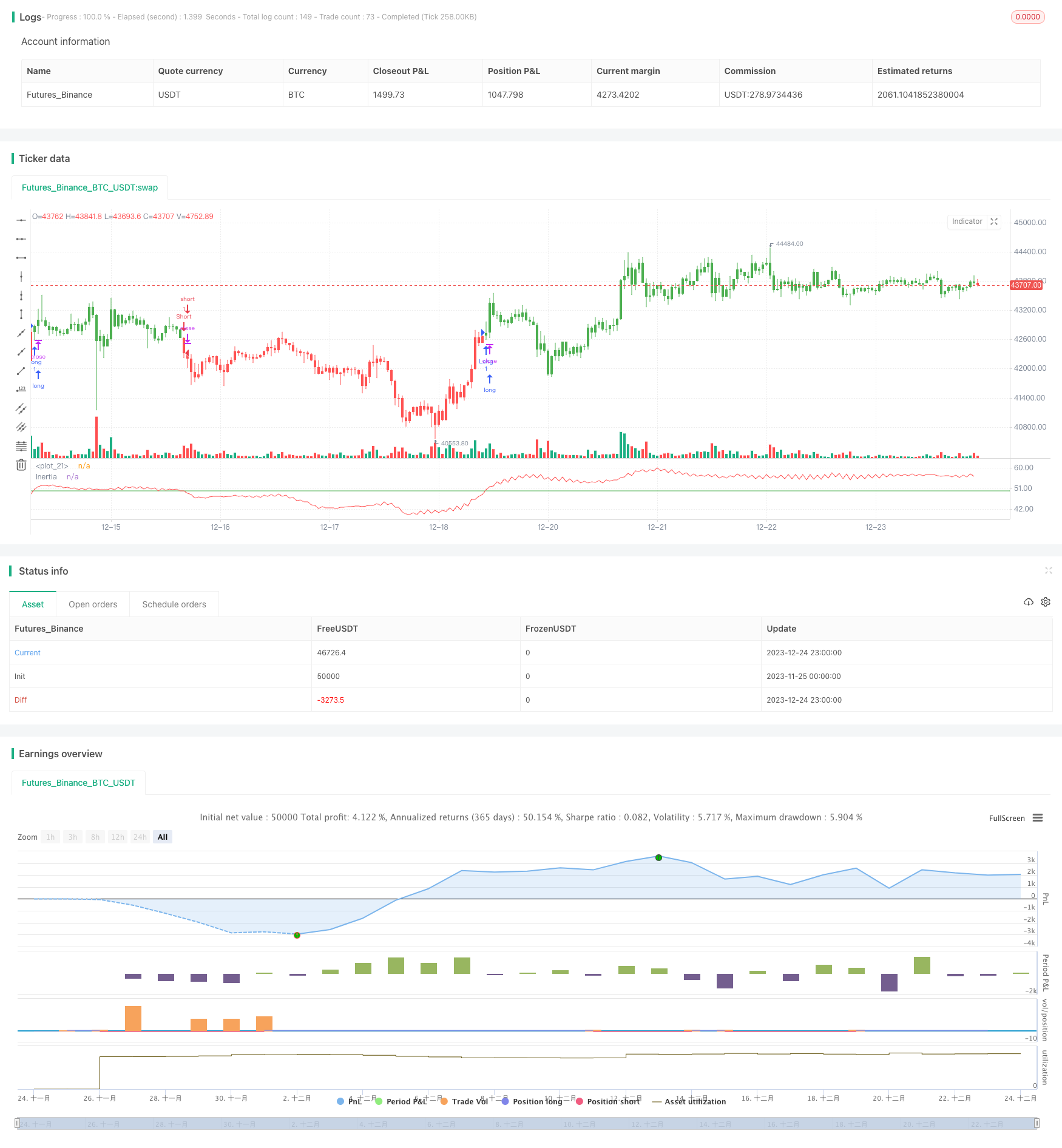慣性指標の取引戦略
作者: リン・ハーンチャオチャン,日付: 2023-12-26 15:42:33タグ:

概要
慣性指標取引戦略は,相対変動指数 (RVI) をベースとしたトレンドフォローするアルゴリズム的な取引戦略である.証券のRVIを計算することによって市場,株式または通貨ペアの勢いと傾向を測定する.長期的なトレンドの方向性を決定し,取引信号を生成することができる.
戦略の論理
この戦略の主要な指標は,慣性の指標値は0から100までの範囲で,50以上の値が正気力を表し,50以下の値が負気力を表す.慣性の値が50以上である限り,上昇傾向を示します.そしてその逆.
計算方法は次のとおりです.
- 決済価格の標準偏差 StdDev を計算する
- 今日と昨日の閉店価格の比較に基づいて,上昇波動 u と下落波動 d を計算する.
- インディケーター nU と nD を取得するためにスムーズ u と d
- 相対変動指数 nRVI = 100 * nU / (nU + nD) を計算する
- 最終慣性値 nRes を得るために指数的に平らな nRVI
nResが50を超えると 購入信号が発信され 50を下回ると 販売信号が発信されます
利点分析
この戦略の最大の利点は,トレンドを追跡し,市場統合中に頻繁な開拓を回避できる.さらに,単純な指標計算には計算資源が少なく,アルゴリズム取引に適している.
リスク分析
最大のリスクは,指標自体に遅れがあり,ターニングポイントを100%捉えることができないこと.これはより良い開拓機会を逃す結果になる可能性があります. さらに,指標のパラメータ設定は戦略パフォーマンスにも影響し,最適なパラメータを見つけるために多くのバックテストが必要です.
リスクを減らすために,他の技術的または基本的指標と組み合わせて,より多くの要因を使用して開口を決定することを検討します.同時に,各取引のポジションサイズを制御します.
オプティマイゼーションの方向性
戦略は以下の側面で最適化できます.
パラメータ最適化.最適なパラメータ組み合わせを見つけるためにサイクルパラメータとスムージングパラメータの設定を変更します.
他の指標と組み合わせる.より情報に基づいた意思決定のために移動平均値,RSI,その他の指標を使用する.
ダイナミックなポジションサイズ 市場の状況と指標値に基づいて,それぞれの取引のポジションサイズをダイナミックに調整します
自動ストップ・ロスト ストップ・ロストポジションを設定して トレード毎の最大損失を効果的に制御します
結論
慣性指標取引戦略は,比較的シンプルで信頼性の高いトレンドフォロー戦略である.慣性指標に基づいて価格トレンド方向を決定し,トレードポジションを確立するトレンドをフォローする.パラメータ最適化,指標組み合わせを通じて戦略パフォーマンスをさらに向上させ,定量取引に適したアルゴリズム戦略である.
/*backtest
start: 2023-11-25 00:00:00
end: 2023-12-25 00:00:00
period: 1h
basePeriod: 15m
exchanges: [{"eid":"Futures_Binance","currency":"BTC_USDT"}]
*/
//@version=2
////////////////////////////////////////////////////////////
// Copyright by HPotter v1.0 23/05/2017
// The inertia indicator measures the market, stock or currency pair momentum and
// trend by measuring the security smoothed RVI (Relative Volatility Index).
// The RVI is a technical indicator that estimates the general direction of the
// volatility of an asset.
// The inertia indicator returns a value that is comprised between 0 and 100.
// Positive inertia occurs when the indicator value is higher than 50. As long as
// the inertia value is above 50, the long-term trend of the security is up. The inertia
// is negative when its value is lower than 50, in this case the long-term trend is
// down and should stay down if the inertia stays below 50.
//
// You can change long to short in the Input Settings
// Please, use it only for learning or paper trading. Do not for real trading.
////////////////////////////////////////////////////////////
strategy(title="Inertia Indicator", shorttitle="Inertia")
Period = input(10, minval=1)
Smooth = input(14, minval=1)
reverse = input(false, title="Trade reverse")
hline(50, color=green, linestyle=line)
xPrice = close
StdDev = stdev(xPrice, Period)
d = iff(close > close[1], 0, StdDev)
u = iff(close > close[1], StdDev, 0)
nU = (13 * nz(nU[1],0) + u) / 14
nD = (13 * nz(nD[1],0) + d) / 14
nRVI = 100 * nU / (nU + nD)
nRes = ema(nRVI, Smooth)
pos = iff(nRes > 50, 1,
iff(nRes < 50, -1, nz(pos[1], 0)))
possig = iff(reverse and pos == 1, -1,
iff(reverse and pos == -1, 1, pos))
if (possig == 1)
strategy.entry("Long", strategy.long)
if (possig == -1)
strategy.entry("Short", strategy.short)
barcolor(possig == -1 ? red: possig == 1 ? green : blue )
plot(nRes, color=red, title="Inertia")
- 量子ビットコイン取引戦略 MACD,RSI,FIBを組み合わせる
- 二重移動平均金十字量的な戦略
- 負債の負債と負債の負債の負債の負債の負債の負債の負債
- イチモクバランスライン戦略
- 二重移動平均クロスオーバー戦略を持つイチモククラウド
- ATRとブレイクアウトに基づくETF取引戦略
- 超トレンド戦略を追跡する
- 移動平均的な封筒取引戦略
- 二重移動平均金十字量的な戦略
- 二重トレンドシグナルを統合する定量逆転指数戦略
- Bollinger Band RSI のデュアルライン戦略
- ダイナミックサポートレジスタンスのブレイクトレンド戦略
- レインボーオシレーターバックテスト戦略
- ラリー・ウィリアムズの移動平均のクロスオーバー戦略
- オシレーター差動移動平均のタイミング戦略
- ダイナミックストップ・ロスのDMIとストカスティック・トレーディング・戦略
- 2つの要素を組み合わせた反転と質量指数戦略
- 二重トレンドフィルターに基づく定量的な取引戦略
- ストカスティックRSIモメントオシレーション取引戦略
- Bollinger 帯がRSI コールバックで価格を下回るときのショートセール取引戦略